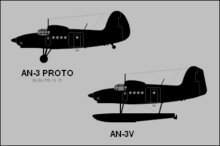|
Antonov An-3
The Antonov An-3 is a Soviet (later Ukrainian and Russian) civil multipurpose and agricultural aircraft. It is essentially a turboprop-powered development of the An-2, designed to upgrade or replace it. The basic transport version (An-3T) is supplemented by a cargo/passenger version (An-3TK), an agricultural version (An-3SH), a forest fire-fighting version (An-3P), as well as an ambulance version.[1][2] It is designed to carry passengers and cargo, operating from paved or unpaved airfields, including snow covered surfaces up to 35 cm (14 in) deep (using a ski landing gear).[3] UpgradingThe upgrading consisted of replacement of the piston engine with a 1,025 kW (1,375 shp) TVD-20 turboprop engine, featuring a three-blade reversible pitch (type AV-17) propeller and a R-17 speed governor. The flight compartment was rearranged; a heating and ventilation system was installed as well as advanced electric and flight and navigation equipment; centralized warning system; a new fire extinguishing system; and an improvement of the external wide-spreading dispensing equipment for agricultural needs. The upgrades allowed the aircraft to be more reliable and to increase the cargo lifting capacity of the aircraft by 20%, as well as ensuring more comfortable conditions for the crew, including the lowering of the noise and vibration inside the cockpit. The rate of climb was increased by 1.9 times, and the take-off and landing performance of the aircraft was increased. The upgrading allowed the use of kerosene and lubricants commonly used for other aircraft instead of gasoline.[2] The take-off weight and payload was also increased and the upgrade allowed the landing performance to use ground strips 500 metres (1,600 ft) long.[1] The upgrading was arranged at both the "Polyot" Production Association in Omsk, Russian Federation, and at Antonov ASTC, Kyiv, Ukraine.[3] The first example flew as early as May 13, 1980, but because of a lack of official interest in the project, work proceeded very slowly. Flight testing was not complete until 1991. It is one of the few turbine-powered biplane designs to date. The An-3T received its Type Certificate on 31 August 2000. Supplements to the Type Certificate included version with ski landing gear and an agricultural version.[2] VariantsThe project was revitalised in the late 1990s when it was taken over by Polyot State Aerospace Enterprise, and a marketing campaign began in earnest in 2000, although sales have been limited. It is available in four forms, the basic transport version (An-3T), the convertible cargo/passenger able to carry 12 passengers or 1,800 kg (4,000 lb) of cargo (An-3TK)k the agricultural aircraft (An-3SH—"Selsko-Khosiajstwenni") and the fire-fighting version (An-3P).[2] Another attempt to replace the An-2 on Soviet farms was made in the 1970s with the WSK-Mielec M-15 Belphegor, but it failed. From 2007, the "Polyot" Production Association started to upgrade the first ten An-2s of the Russian Airborne Troops to An-3T-10 standard. The overall requirement is estimated at approximately 200 aircraft.[4][5] Specifications (An-3T)  Data from Antonov An-2[6] General characteristics
Performance
Accidents and incidents
See alsoRelated development Aircraft of comparable role, configuration, and era
References
External linksWikimedia Commons has media related to Antonov An-3. |
||||||||||||||||||||||||||||||
